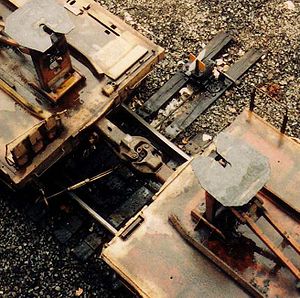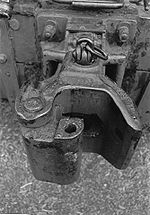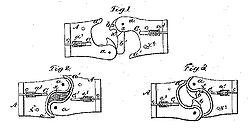
Janney coupler
Encyclopedia


Association of American Railroads
The Association of American Railroads is an industry trade group representing primarily the major freight railroads of North America . Amtrak and some regional commuter railroads are also members...
) is an automatic coupler patent
Patent
A patent is a form of intellectual property. It consists of a set of exclusive rights granted by a sovereign state to an inventor or their assignee for a limited period of time in exchange for the public disclosure of an invention....
ed by Eli H. Janney
Eli H. Janney
Eli H. Janney , aka Eli Hamilton Janney or simply Eli Janney, was the inventor of the modern knuckle coupler that replaced link and pin couplers on North American railroads....
in 1873.
History

Alexandria, Virginia
Alexandria is an independent city in the Commonwealth of Virginia. As of 2009, the city had a total population of 139,966. Located along the Western bank of the Potomac River, Alexandria is approximately six miles south of downtown Washington, D.C.Like the rest of northern Virginia, as well as...
, who used his lunch hours to whittle from wood an alternative to the link and pin coupler. The term Buckeye comes from the nickname of the US state of Ohio
Ohio
Ohio is a Midwestern state in the United States. The 34th largest state by area in the U.S.,it is the 7th‑most populous with over 11.5 million residents, containing several major American cities and seven metropolitan areas with populations of 500,000 or more.The state's capital is Columbus...
, the "Buckeye state" and the Ohio Brass Company which originally marketed the coupling.
In 1893, satisfied that an automatic coupler could meet the demands of commercial railroad operations and, at the same time, be manipulated safely, the United States Congress
United States Congress
The United States Congress is the bicameral legislature of the federal government of the United States, consisting of the Senate and the House of Representatives. The Congress meets in the United States Capitol in Washington, D.C....
passed the Safety Appliance Act. Its success in promoting switchyard safety was stunning. Between 1877 and 1887, approximately 38% of all railworker accidents involved coupling. That percentage fell as the railroads began to replace link and pin couplers with automatic couplers. By 1902, only two years after the SAA's effective date, coupling accidents constituted only 4% of all employee accidents. Coupler-related accidents dropped from nearly 11,000 in 1892 to just over 2,000 in 1902, even though the number of railroad employees steadily increased during that decade.
When the Janney coupling was chosen to be the American standard, there were 8,000 patented alternatives to choose from. The only significant disadvantage of using the AAR (Janney) design is that sometimes the drawheads need to be manually aligned.
AAR coupler
The AAR coupler is used in CanadaRail transport in Canada
Canada has a large and well-developed railway system that today transports primarily freight. There are two major privately owned transcontinental freight railway systems, the Canadian National and Canadian Pacific Railway. Nation-wide passenger services are provided by the federal crown...
, the United States
Rail transport in the United States
Presently, most rail transport in the United States is based on freight train shipments. The U.S. rail industry has experienced repeated convulsions due to changing U.S. economic needs and the rise of automobile, bus, and air transport....
, Mexico
Rail transport in Mexico
Mexico has a freight railway system that is privately owned and extends across most of the country, connecting major industrial centers with ports and with rail connections at the United States border...
, Japan
Rail transport in Japan
Rail transport in Japan is a major means of passenger transport, especially for mass and high-speed travel between major cities and for commuter transport in metropolitan areas.-Overview:...
, Australia
Rail transport in Australia
Rail transport in Australia is a crucial aspect of the Australian transport network, and an enabler of the wider Australian economy. Rail in Australia is to a large extent state-based. The Australian rail network consists of a total of 41,461 km of track of three major gauges, of which...
, South Africa
Rail transport in South Africa
Rail transport in South Africa is the most important element of the country's transport infrastructure. All major cities are connected by rail, and South Africa's railway system is the most highly developed in Africa...
, Saudi Arabia
Rail transport in Saudi Arabia
The Saudi Railways Organization provides freight services on two main lines totalling 1018 km. These connect Riyadh with the Persian Gulf port of Dammam...
, Cuba, Chile, Brazil
Rail transport in Brazil
Rail transport in Brazil began in the 19th century and there were many different railway companies. The railways were nationalised under RFFSA in 1957...
, China
Rail transport in the People's Republic of China
Rail transport is the most commonly used mode of long-distance transportation in the People's Republic of China. Almost all rail operations are handled by the Ministry of Railways, which is part of the State Council of the People's Republic of China...
and elsewhere. Among its features:
- Maximum tonnage as high as 32000 t (35,274 ST; 31,494.5 LT) such as on the Fortescue Railway.
- Minimum Ultimate Tensile Strength:
- Grade E Knuckles:650000 pound-forces (2.9 MN)
- Only Grade C or Grade E Knuckles are permissible in interchange service.
- Grade E Coupler Bodies:900000 pound-forces (4 MN)
- Grade E Knuckles:650000 pound-forces (2.9 MN)
- Many AAR Coupler designs exist to accommodate requirements of various car designs, but all are required to have certain dimensions in common which allow for one design to couple to any other.
- Lighter weight railways, especially those of narrow gauge or with no need for Interchange (freight rail)Interchange (freight rail)In freight rail transport, interchange is the practice of railroads conveying freight cars from other companies over their lines...
sometimes use smaller (three-quarter- or half-size) versions of the AAR coupling.
- Lighter weight railways, especially those of narrow gauge or with no need for Interchange (freight rail)
- AAR couplers are always right-handed.
- Required Coupler Heights
- Empty Cars: 33.5 inches (85.1 cm) +/- 1 inches (2.5 cm)
- Loaded Cars: 32.5 inches (82.6 cm) in +/- 1 inches (2.5 cm)
- AAR couplers are uncoupled by lifting the coupling pin with a lever at the corner of the car. This pin is locked when the coupler is under tension, so the usual uncoupling steps are to compress the coupling with a locomotive, lift and hold up the pin, then pull the cars apart. Side operated variants are called the "Sharon coupler" or "Buckeye coupler".
- Trains fitted with AAR couplers can accommodate heavier loads than any other type of coupler. Thus the heaviest coal trains in New ZealandNew ZealandNew Zealand is an island country in the south-western Pacific Ocean comprising two main landmasses and numerous smaller islands. The country is situated some east of Australia across the Tasman Sea, and roughly south of the Pacific island nations of New Caledonia, Fiji, and Tonga...
have AAR couplings even though the remainder of the fleet has the "meat chopperNorwegian couplingA Norwegian coupling or meat chopper is a manual coupling consisting of a central buffer with a mechanical hook that drops into a slot in the central buffer...
" kind. Also, long-distance freight trains in North AmericaNorth AmericaNorth America is a continent wholly within the Northern Hemisphere and almost wholly within the Western Hemisphere. It is also considered a northern subcontinent of the Americas...
are commonly more than 1 miles (1.6 km) long, whereas this is not seen in EuropeEuropeEurope is, by convention, one of the world's seven continents. Comprising the westernmost peninsula of Eurasia, Europe is generally 'divided' from Asia to its east by the watershed divides of the Ural and Caucasus Mountains, the Ural River, the Caspian and Black Seas, and the waterways connecting...
, where most freight trains still use the buffers and chain system.
Changes since 1873

- The current AAR contour dates back to the Master Car Builders Association (MCBA) coupler.
- Buckeye coupler, a side operated version of the MCBA coupler
- Type "E" coupler, the original (plain) AAR coupler, derived from the Master Car Builders Association coupler.
- Type "F" coupler, a "tooth and socket" or "tightlock" variation to prevent accidents, derailments and wrecks from uncoupling the couplers. The "tooth" on a loose coupler could puncture any tank carTank carA tank car is a type of railroad rolling stock designed to transport liquid and gaseous commodities.-Timeline:...
or other car carrying hazardous materials. Variations on the AAR type "F" coupler have been devised to provide extra protection, in case of derailments and train wrecks, to cars routinely carrying sensitive or hazardous loads. These variations of type "F" couplers, generally involving "shelves", remain fully compatible with standard AAR couplers, but tend to keep derailmentDerailmentA derailment is an accident on a railway or tramway in which a rail vehicle, or part or all of a train, leaves the tracks on which it is travelling, with consequent damage and in many cases injury and/or death....
s and collisionsTrain wreckA train wreck or train crash is a type of disaster involving one or more trains. Train wrecks often occur as a result of miscommunication, as when a moving train meets another train on the same track; or an accident, such as when a train wheel jumps off a track in a derailment; or when a boiler...
from uncoupling the cars (thereby preventing the "tooth" of the couplers from piercing the ends of the cars).
- The APTA (former AAR) standard type "H" coupler, a "tooth and socket" or "tightlock" variation used mostly, if not exclusively, on passenger cars. The Type "H" coupler is now under the supervision of the APTA (American Public Transportation AssociationAmerican Public Transportation AssociationThe American Public Transportation Association is a non-profit organization which serves as an advocate for the advancement of public transportation programs and initiatives in the United States. Since its founding in 1882, APTA has educated the public about the benefits of public transportation...
)
- Types "F" and "H" couplers are also known as tightlock couplingTightlock couplingTightlock coupling or titelok coupler is an Association of American Railroads tooth and toothbrush automatic coupler of which there are two types:...
s.
- "Pads" to reduce slack on passenger trains.
- Improvement to castings, etc. to increase maximum trailing load.
- Rotating-shaft couplers (type "F") introduced for use in rotary car dumperRotary car dumperA rotary car dumper or wagon tippler is a mechanism used for unloading certain railroad cars such as hopper cars, gondolas or lorries . It holds the rail car to a section of track and rotates the track and car together to dump out the contents. Used with gondola cars, it is making open hopper cars...
s such as on the Pilbara railways.
- Narrow gauge railways such as the VictorianVictoria (Australia)Victoria is the second most populous state in Australia. Geographically the smallest mainland state, Victoria is bordered by New South Wales, South Australia, and Tasmania on Boundary Islet to the north, west and south respectively....
Puffing Billy Railway use a miniature version of the AAR coupler.

